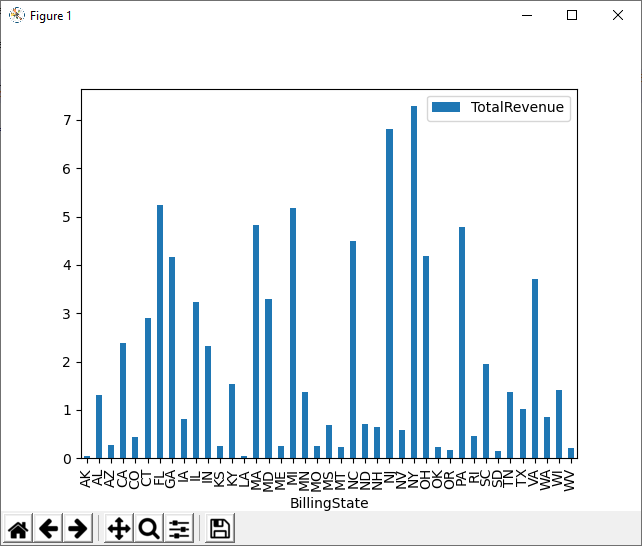Model Context Protocol (MCP) finally gives AI models a way to access the business data needed to make them really useful at work. CData MCP Servers have the depth and performance to make sure AI has access to all of the answers.
Try them now for free →How to Visualize Bullhorn CRM Data in Python with pandas
Use pandas and other modules to analyze and visualize live Bullhorn CRM data in Python.
The rich ecosystem of Python modules lets you get to work quickly and integrate your systems more effectively. With the CData Python Connector for Bullhorn CRM, the pandas & Matplotlib modules, and the SQLAlchemy toolkit, you can build Bullhorn CRM-connected Python applications and scripts for visualizing Bullhorn CRM data. This article shows how to use the pandas, SQLAlchemy, and Matplotlib built-in functions to connect to Bullhorn CRM data, execute queries, and visualize the results.
With built-in optimized data processing, the CData Python Connector offers unmatched performance for interacting with live Bullhorn CRM data in Python. When you issue complex SQL queries from Bullhorn CRM, the driver pushes supported SQL operations, like filters and aggregations, directly to Bullhorn CRM and utilizes the embedded SQL engine to process unsupported operations client-side (often SQL functions and JOIN operations).
Connecting to Bullhorn CRM Data
Connecting to Bullhorn CRM data looks just like connecting to any relational data source. Create a connection string using the required connection properties. For this article, you will pass the connection string as a parameter to the create_engine function.
Begin by providing your Bullhorn CRM account credentials in the following:
- DataCenterCode: Set this to the data center code which responds to your data center. Refer to the list of data-center-specific Bullhorn API URLs: https://bullhorn.github.io/Data-Center-URLs/
If you are uncertain about your data center code, codes like CLS2, CLS21, etc. are cluster IDs that are contained in a user's browser URL (address bar) once they are logged in.
Example: https://cls21.bullhornstaffing.com/BullhornSTAFFING/MainFrame.jsp?#no-ba... indicates that the logged in user is on CLS21.
Authenticating with OAuth
Bullhorn CRM uses the OAuth 2.0 authentication standard. To authenticate using OAuth, create and configure a custom OAuth app. See the Help documentation for more information.
Follow the procedure below to install the required modules and start accessing Bullhorn CRM through Python objects.
Install Required Modules
Use the pip utility to install the pandas & Matplotlib modules and the SQLAlchemy toolkit:
pip install pandas pip install matplotlib pip install sqlalchemy
Be sure to import the module with the following:
import pandas import matplotlib.pyplot as plt from sqlalchemy import create_engine
Visualize Bullhorn CRM Data in Python
You can now connect with a connection string. Use the create_engine function to create an Engine for working with Bullhorn CRM data.
engine = create_engine("bullhorncrm:///?DataCenterCode=CLS33&OAuthClientId=myoauthclientid&OAuthClientSecret=myoauthclientsecret&InitiateOAuth=GETANDREFRESH&OAuthSettingsLocation=/PATH/TO/OAuthSettings.txt")
Execute SQL to Bullhorn CRM
Use the read_sql function from pandas to execute any SQL statement and store the resultset in a DataFrame.
df = pandas.read_sql("SELECT Id, CandidateName FROM Candidate WHERE CandidateName = 'Jane Doe'", engine)
Visualize Bullhorn CRM Data
With the query results stored in a DataFrame, use the plot function to build a chart to display the Bullhorn CRM data. The show method displays the chart in a new window.
df.plot(kind="bar", x="Id", y="CandidateName") plt.show()

Free Trial & More Information
Download a free, 30-day trial of the CData Python Connector for Bullhorn CRM to start building Python apps and scripts with connectivity to Bullhorn CRM data. Reach out to our Support Team if you have any questions.
Full Source Code
import pandas
import matplotlib.pyplot as plt
from sqlalchemy import create_engin
engine = create_engine("bullhorncrm:///?DataCenterCode=CLS33&OAuthClientId=myoauthclientid&OAuthClientSecret=myoauthclientsecret&InitiateOAuth=GETANDREFRESH&OAuthSettingsLocation=/PATH/TO/OAuthSettings.txt")
df = pandas.read_sql("SELECT Id, CandidateName FROM Candidate WHERE CandidateName = 'Jane Doe'", engine)
df.plot(kind="bar", x="Id", y="CandidateName")
plt.show()

